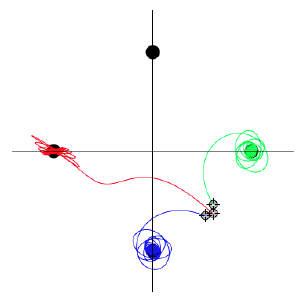Post
Butterfly Effect
30 November 2012
Chaos theory is often expressed by the butterfly effect. Stated simply, the butterfly effect is the idea that the flutter of a butterfly’s wings in China can cause a chain of effects that results in a hurricane striking Florida. It is a representation of a non-linear system, where a small event can trigger a much larger one. Such non-linear systems are fairly common. For example, interstellar gas clouds can be triggered by a shock wave from a supernova or collision with another gas cloud. Thus the flicker of a dying star can trigger the formation of a stellar nursery which results in the formation of dozens or hundreds of new stars.
 BK
BKA common aspect of such non-linear phenomena is that the large scale results are always the same, but the small scale effects can be dramatically different. With the interstellar cloud example, the cloud has to be on a razor edge, known as the Jeans instability, where a small “push” is enough to initiate the collapse of the cloud. If it is on that razor’s edge, then any supernova in the general area could trigger the collapse, which will result in the formation of lots of new stars. However if supernova A triggers things, it might produce a few hundred mid-size stars. If supernova B triggers things, it might produce a few dozen very large stars. Any trigger can form the stellar nursery, but the specific nature of the trigger can produce a very different outcome in terms of the the size and number of stars. It is this latter aspect that is chaotic.
You can see a similar effect in the figure above. The black dots represent magnets, and the lines represent the path of a simple iron-bar pendulum. When the pendulum is released, it will eventually be captured by one of the magnets. That outcome is assured. However the specific magnet that captures it depends critically on the starting point of the pendulum. As you can see, a slight change in the initial condition leads to very different outcomes.